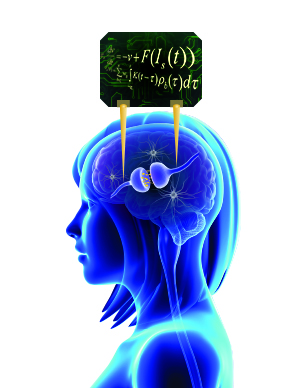Center testbeds, as the name implies, allow researchers to test new technologies, computational tools and theories being explored in Center for Neurotechnology (CNT) research thrusts.

The testbeds serve as proof-of-principle integrated systems that test and validate the CNT’s vision of engineered neuroplasticity. Engineered neuroplasticity is a new form of rehabilitation that uses engineered devices to restore lost or injured connections in the brain, spinal cord and other areas of the nervous system.
Pictured: An engineered neural device runs mathematical algorithms (top), which control delivery of electrical stimulation to targeted neurons in the brain (middle). This targeted electrical stimulation changes the strength of synaptic connections in the brain, resulting in improved health and function after a brain or spinal cord injury.
Cortical Plasticity Testbed
The goal of this testbed is to engineer neuroplasticity in the brain, improving the brain’s ability to adapt and recover after injury. It is targeted toward people with neurological disorders such as stroke. This is where we will test the ability of our neural stimulation protocols to induce activity-dependent neuroplasticity by remodeling neural connections between cortical regions in the brain.
Related reading: “Using mathematics to help heal the brain”
Spinal Plasticity Testbed
Here, we directly test our ability to engineer neuroplasticity within the spinal cord after injury. For example, we are using electrical spinal stimulation synchronized with residual muscle activity or movement in order to produce lasting improvements in hand and arm function after spinal cord injury.
Related reading: “New, non-invasive treatment improves hand and arm function in people with spinal cord injury”
Co-adaptation Testbed
This testbed focuses on understanding and developing mathematical algorithms designed to help a brain-computer interface co-adapt with the brain itself in a neural stimulation system. An example of work in this testbed is to quantify large-scale cortical dynamics during learning and neuroplasticity induction, as well as changes in cortical dynamics that occur when users directly control brain stimulation using their thoughts.
Related reading: “Brain signals deliver first targeted treatment for world’s most common movement disorder”
